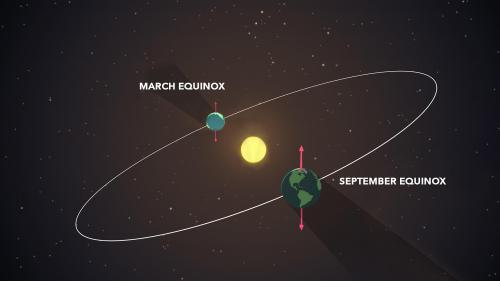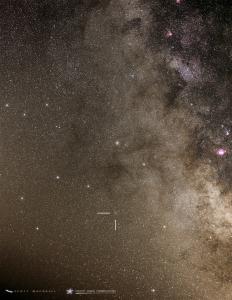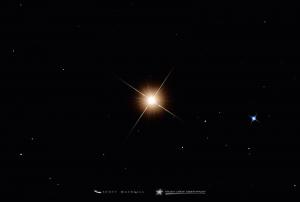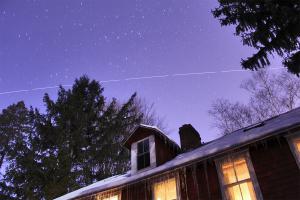Celebration of Space - March 15, 2024
On Tuesday, March 19, 2024 at 11:07 pm ET, Earth will arrive at the point in our orbit where we are neither tilted towards or away from the Sun. This is the Vernal Equinox, and marks the first day of spring in the Northern Hemisphere. Equinox is Latin for “Equal-night”, and on the Equinox, all locations on Earth will experience an equal amount of daytime and nighttime periods. Sky watchers that reside along the Equator will experience the Sun rising due east, cross the zenith at noon (pass directly overhead), and set due west. The Vernal Equinox also signals a shift in daytime length to a period where the daytime is longer than the nighttime in the Northern Hemisphere, as we commence our push towards the summer season. So take a moment on Tuesday to step outside and welcome spring, and all the mud, mosquitoes, and pollen everywhere that comes with it.
There is a star in the constellation Corona Borealis that is so dim that you cannot see it without a telescope. Which in itself is not abnormal and is pretty much the case for the vast majority of stars in the sky. This star is referred to as T CrB (T Corona Borealis), and it shines at about visible magnitude 10.5, which is pretty dim. To put this into visual thinking, the brightest star in the constellation Corona Borealis is Alphecca, which has a visible magnitude of 2.20. T CrB is about 1,381 times dimmer than Alphecca. Arcturus, which is about 20° away from Alphecca and is one of the brightest stars in the sky, has a visible magnitude of 0.15. T CrB is over 9,124 times dimmer than Arcturus! Okay, so now that we have emphasized how dim this star is, we can move on to why it is notable.
T CrB is a binary star, which is a star system composed of two stars that share a common center point of gravity – called a barycenter. But one of T CrB’s stars has died, and collapsed into a white dwarf. That process changed the orbit of that star around the barycenter, resulting in an oval-shaped orbit. During the periods that the white dwarf will orbit closest to the star that is still alive, it will steal matter from the star in the form of hydrogen, in a process called accretion. All of this stolen hydrogen will collect on the surface of the white dwarf. When enough matter is accreted to increase the mass of the white dwarf to 1.44 solar masses, the accreted hydrogen will fuse, but this happens all at once and on the surface of the star, instead of inside the core. The rapid level of fusion will eject the accreted matter from the surface of the white dwarf. This process will cause the star to become very bright, thousands of times brighter, for a short period of time. This event is called a Nova, which is Latin for “new” because if the event becomes visible to the naked eye, it will look like a new star in the sky.
T Corona Borealis undergoes this process once every 80 years. When it happens, T CrB will jump from magnitude 10 to magnitude 2, which is about the same brightness as Alphecca. The last time this occurred was in 1946, and it is expected to occur again this year between February and September, which is notable because that is the time that this star is in our nighttime sky. T CrB is found about 5.1° eastward from Alphecca. At Frosty Drew, we will monitor T CrB for changes in brightness and will post updates as needed. So keep your fingers crossed for a stunning naked eye Nova this year!
This coming Thursday, March 21, 2024, Venus and Saturn will arrive at their visibly closest point in conjunction, at about 0.5° apart from each other. Venus and Saturn are currently sitting in the predawn morning sky, and will be too low on the horizon to see before sunrise, unless you’re near the Equator. But Venus and Saturn are both visible in a telescope during the day (Venus is visible to the naked eye during the day). The conjunction will occur about 19.5° westward of the Sun, which is not too close to the Sun, but also a risky attempt for someone not used to celestial observation during the daytime. If you are confident with your daytime telescope skills, you could attempt a view. To do so you will need a telescope, and enough skill to not mistakenly direct the telescope towards the Sun. It sounds silly, but you will be surprised how easy it is to scan over the Sun when searching for the conjunction. The best time to catch a view will be later in the afternoon when Saturn and Venus are closest. If you happen to see it let us know. If you catch a photo of the conjunction, send it to us as a reply to this email as we would love to see it!
Evening passes of the International Space Station (ISS) over our region continue this week, with a couple of fabulous passes scheduled for this weekend. Being that the ISS orbits Earth inclined 51° to the equator, we will have the ISS pass over every day, but not during the times necessary to catch a view. To see the station, it has to be in direct sunlight, while the observer’s location is in darkness. It is reflected sunlight that we see when we observe satellites passing overhead. As we move towards the Summer Solstice in the Northern Hemisphere, sighting opportunities become much more common. The ISS is currently orbiting over our location during the right times for these requirements to be met. Here are several notable passes of the ISS over our location for the next seven days:
Fri, Mar 15 at 8:08 pm, starting in the WSW, rising to 64°, heading towards the NE, and into orbital sunset ← Fabulous pass!
Sat, Mar 16 at 7:20 pm, starting in the SW, rising to 76°, heading towards the ENE ← Fabulous pass!
Sun, Mar 17 at 8:10 pm, starting in the W, rising to 29°, heading towards the NE, and into orbital sunset
Mon, Mar 18 at 7:22 pm, starting in the W, rising to 41°, heading towards the NE
Tue, Mar 19 at 8:12 pm, starting in the WNW, rising to 18°, heading towards the N, and into orbital sunset
Wed, Mar 20 at 7:24 pm, starting in the WNW, rising to 22°, heading towards the NE
Note that these times are applicable for Southern New England, and are usable for the entire Northeast region. For daily pass times of the ISS and other bright satellites, visit the Frosty Drew Daily Satellite Pass Prediction Utility.
- Author:
- Scott MacNeill
- Entry Date:
- Mar 15, 2024
- Published Under:
- Scott MacNeill's Columns





